BIZ301: Case Study Analysis of Apple's Innovation Strategy
VerifiedAdded on 2023/06/03
|7
|1750
|450
Case Study
AI Summary
This case study delves into Apple's organizational creativity and innovation, examining its business strategies and how it fosters a culture of innovation. It analyzes Apple's approach to identifying and meeting customer needs, emphasizing design thinking and simplicity. The report highlights the influence of people, including Steve Jobs, and organizational culture on Apple's innovative capabilities. It explores how Apple's business model supports and reinforces innovative ideas, and how the company maintains its competitive advantage by prioritizing customer needs and continuously improving its products. The study also investigates the impact of Steve Jobs on the company's values and principles, particularly his emphasis on simplicity in design and attention to detail. The analysis provides insights into Apple's commitment to innovation and its impact on the technology industry.

Organizational Creativity and Innovation
Paraphrase This Document
Need a fresh take? Get an instant paraphrase of this document with our AI Paraphraser

Table of Contents
Introduction...............................................................................................................................2
Innovation and Strategy at Apple..............................................................................................2
Role of Customers in Apple’s Innovation Approach..................................................................3
Influence of people and culture in Apple...................................................................................3
Impact of Steve Jobs on Apple and his view of process and innovation...................................4
Conclusion..................................................................................................................................4
References..................................................................................................................................6
Page 1
Introduction...............................................................................................................................2
Innovation and Strategy at Apple..............................................................................................2
Role of Customers in Apple’s Innovation Approach..................................................................3
Influence of people and culture in Apple...................................................................................3
Impact of Steve Jobs on Apple and his view of process and innovation...................................4
Conclusion..................................................................................................................................4
References..................................................................................................................................6
Page 1
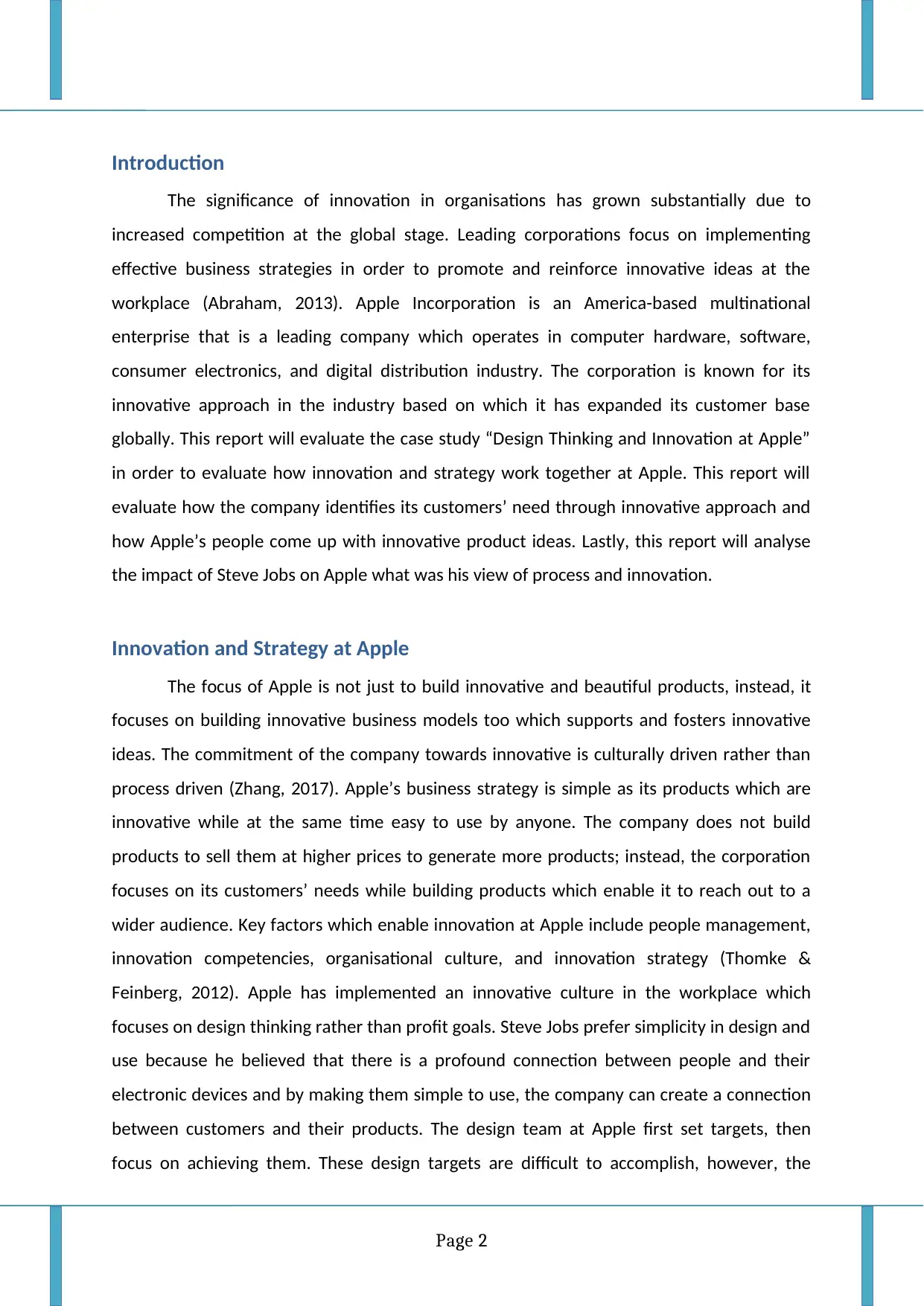
Introduction
The significance of innovation in organisations has grown substantially due to
increased competition at the global stage. Leading corporations focus on implementing
effective business strategies in order to promote and reinforce innovative ideas at the
workplace (Abraham, 2013). Apple Incorporation is an America-based multinational
enterprise that is a leading company which operates in computer hardware, software,
consumer electronics, and digital distribution industry. The corporation is known for its
innovative approach in the industry based on which it has expanded its customer base
globally. This report will evaluate the case study “Design Thinking and Innovation at Apple”
in order to evaluate how innovation and strategy work together at Apple. This report will
evaluate how the company identifies its customers’ need through innovative approach and
how Apple’s people come up with innovative product ideas. Lastly, this report will analyse
the impact of Steve Jobs on Apple what was his view of process and innovation.
Innovation and Strategy at Apple
The focus of Apple is not just to build innovative and beautiful products, instead, it
focuses on building innovative business models too which supports and fosters innovative
ideas. The commitment of the company towards innovative is culturally driven rather than
process driven (Zhang, 2017). Apple’s business strategy is simple as its products which are
innovative while at the same time easy to use by anyone. The company does not build
products to sell them at higher prices to generate more products; instead, the corporation
focuses on its customers’ needs while building products which enable it to reach out to a
wider audience. Key factors which enable innovation at Apple include people management,
innovation competencies, organisational culture, and innovation strategy (Thomke &
Feinberg, 2012). Apple has implemented an innovative culture in the workplace which
focuses on design thinking rather than profit goals. Steve Jobs prefer simplicity in design and
use because he believed that there is a profound connection between people and their
electronic devices and by making them simple to use, the company can create a connection
between customers and their products. The design team at Apple first set targets, then
focus on achieving them. These design targets are difficult to accomplish, however, the
Page 2
The significance of innovation in organisations has grown substantially due to
increased competition at the global stage. Leading corporations focus on implementing
effective business strategies in order to promote and reinforce innovative ideas at the
workplace (Abraham, 2013). Apple Incorporation is an America-based multinational
enterprise that is a leading company which operates in computer hardware, software,
consumer electronics, and digital distribution industry. The corporation is known for its
innovative approach in the industry based on which it has expanded its customer base
globally. This report will evaluate the case study “Design Thinking and Innovation at Apple”
in order to evaluate how innovation and strategy work together at Apple. This report will
evaluate how the company identifies its customers’ need through innovative approach and
how Apple’s people come up with innovative product ideas. Lastly, this report will analyse
the impact of Steve Jobs on Apple what was his view of process and innovation.
Innovation and Strategy at Apple
The focus of Apple is not just to build innovative and beautiful products, instead, it
focuses on building innovative business models too which supports and fosters innovative
ideas. The commitment of the company towards innovative is culturally driven rather than
process driven (Zhang, 2017). Apple’s business strategy is simple as its products which are
innovative while at the same time easy to use by anyone. The company does not build
products to sell them at higher prices to generate more products; instead, the corporation
focuses on its customers’ needs while building products which enable it to reach out to a
wider audience. Key factors which enable innovation at Apple include people management,
innovation competencies, organisational culture, and innovation strategy (Thomke &
Feinberg, 2012). Apple has implemented an innovative culture in the workplace which
focuses on design thinking rather than profit goals. Steve Jobs prefer simplicity in design and
use because he believed that there is a profound connection between people and their
electronic devices and by making them simple to use, the company can create a connection
between customers and their products. The design team at Apple first set targets, then
focus on achieving them. These design targets are difficult to accomplish, however, the
Page 2
⊘ This is a preview!⊘
Do you want full access?
Subscribe today to unlock all pages.

Trusted by 1+ million students worldwide
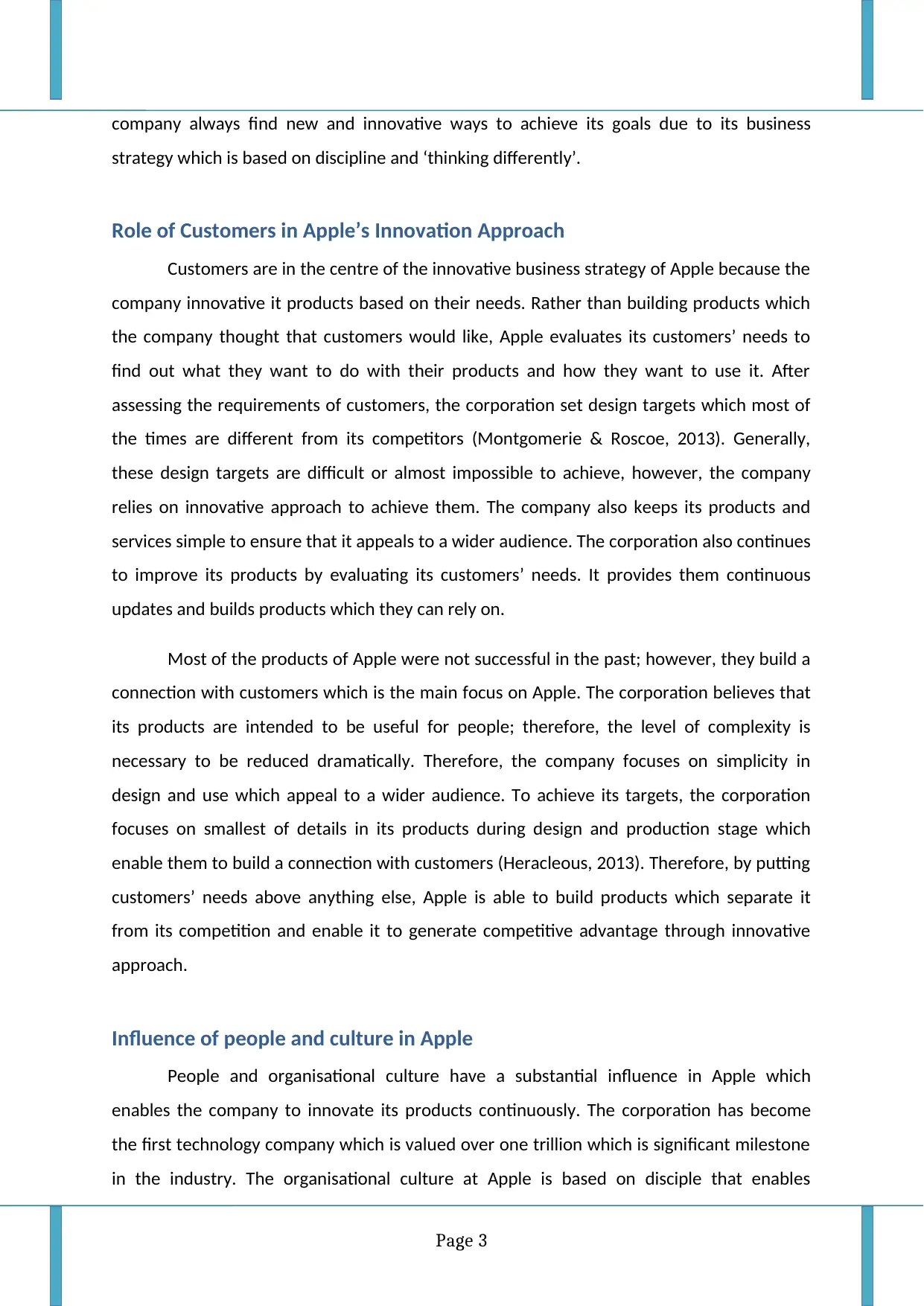
company always find new and innovative ways to achieve its goals due to its business
strategy which is based on discipline and ‘thinking differently’.
Role of Customers in Apple’s Innovation Approach
Customers are in the centre of the innovative business strategy of Apple because the
company innovative it products based on their needs. Rather than building products which
the company thought that customers would like, Apple evaluates its customers’ needs to
find out what they want to do with their products and how they want to use it. After
assessing the requirements of customers, the corporation set design targets which most of
the times are different from its competitors (Montgomerie & Roscoe, 2013). Generally,
these design targets are difficult or almost impossible to achieve, however, the company
relies on innovative approach to achieve them. The company also keeps its products and
services simple to ensure that it appeals to a wider audience. The corporation also continues
to improve its products by evaluating its customers’ needs. It provides them continuous
updates and builds products which they can rely on.
Most of the products of Apple were not successful in the past; however, they build a
connection with customers which is the main focus on Apple. The corporation believes that
its products are intended to be useful for people; therefore, the level of complexity is
necessary to be reduced dramatically. Therefore, the company focuses on simplicity in
design and use which appeal to a wider audience. To achieve its targets, the corporation
focuses on smallest of details in its products during design and production stage which
enable them to build a connection with customers (Heracleous, 2013). Therefore, by putting
customers’ needs above anything else, Apple is able to build products which separate it
from its competition and enable it to generate competitive advantage through innovative
approach.
Influence of people and culture in Apple
People and organisational culture have a substantial influence in Apple which
enables the company to innovate its products continuously. The corporation has become
the first technology company which is valued over one trillion which is significant milestone
in the industry. The organisational culture at Apple is based on disciple that enables
Page 3
strategy which is based on discipline and ‘thinking differently’.
Role of Customers in Apple’s Innovation Approach
Customers are in the centre of the innovative business strategy of Apple because the
company innovative it products based on their needs. Rather than building products which
the company thought that customers would like, Apple evaluates its customers’ needs to
find out what they want to do with their products and how they want to use it. After
assessing the requirements of customers, the corporation set design targets which most of
the times are different from its competitors (Montgomerie & Roscoe, 2013). Generally,
these design targets are difficult or almost impossible to achieve, however, the company
relies on innovative approach to achieve them. The company also keeps its products and
services simple to ensure that it appeals to a wider audience. The corporation also continues
to improve its products by evaluating its customers’ needs. It provides them continuous
updates and builds products which they can rely on.
Most of the products of Apple were not successful in the past; however, they build a
connection with customers which is the main focus on Apple. The corporation believes that
its products are intended to be useful for people; therefore, the level of complexity is
necessary to be reduced dramatically. Therefore, the company focuses on simplicity in
design and use which appeal to a wider audience. To achieve its targets, the corporation
focuses on smallest of details in its products during design and production stage which
enable them to build a connection with customers (Heracleous, 2013). Therefore, by putting
customers’ needs above anything else, Apple is able to build products which separate it
from its competition and enable it to generate competitive advantage through innovative
approach.
Influence of people and culture in Apple
People and organisational culture have a substantial influence in Apple which
enables the company to innovate its products continuously. The corporation has become
the first technology company which is valued over one trillion which is significant milestone
in the industry. The organisational culture at Apple is based on disciple that enables
Page 3
Paraphrase This Document
Need a fresh take? Get an instant paraphrase of this document with our AI Paraphraser
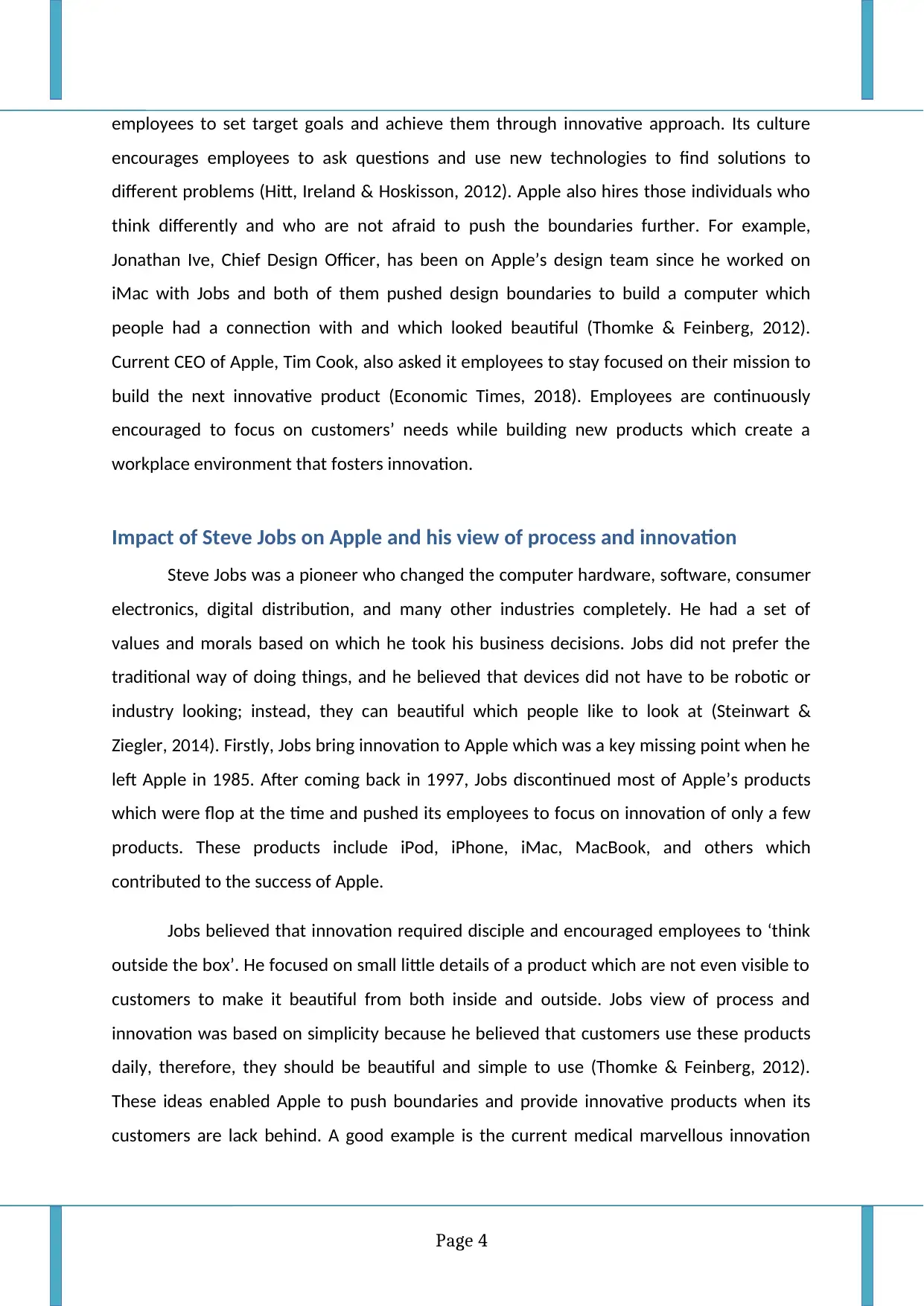
employees to set target goals and achieve them through innovative approach. Its culture
encourages employees to ask questions and use new technologies to find solutions to
different problems (Hitt, Ireland & Hoskisson, 2012). Apple also hires those individuals who
think differently and who are not afraid to push the boundaries further. For example,
Jonathan Ive, Chief Design Officer, has been on Apple’s design team since he worked on
iMac with Jobs and both of them pushed design boundaries to build a computer which
people had a connection with and which looked beautiful (Thomke & Feinberg, 2012).
Current CEO of Apple, Tim Cook, also asked it employees to stay focused on their mission to
build the next innovative product (Economic Times, 2018). Employees are continuously
encouraged to focus on customers’ needs while building new products which create a
workplace environment that fosters innovation.
Impact of Steve Jobs on Apple and his view of process and innovation
Steve Jobs was a pioneer who changed the computer hardware, software, consumer
electronics, digital distribution, and many other industries completely. He had a set of
values and morals based on which he took his business decisions. Jobs did not prefer the
traditional way of doing things, and he believed that devices did not have to be robotic or
industry looking; instead, they can beautiful which people like to look at (Steinwart &
Ziegler, 2014). Firstly, Jobs bring innovation to Apple which was a key missing point when he
left Apple in 1985. After coming back in 1997, Jobs discontinued most of Apple’s products
which were flop at the time and pushed its employees to focus on innovation of only a few
products. These products include iPod, iPhone, iMac, MacBook, and others which
contributed to the success of Apple.
Jobs believed that innovation required disciple and encouraged employees to ‘think
outside the box’. He focused on small little details of a product which are not even visible to
customers to make it beautiful from both inside and outside. Jobs view of process and
innovation was based on simplicity because he believed that customers use these products
daily, therefore, they should be beautiful and simple to use (Thomke & Feinberg, 2012).
These ideas enabled Apple to push boundaries and provide innovative products when its
customers are lack behind. A good example is the current medical marvellous innovation
Page 4
encourages employees to ask questions and use new technologies to find solutions to
different problems (Hitt, Ireland & Hoskisson, 2012). Apple also hires those individuals who
think differently and who are not afraid to push the boundaries further. For example,
Jonathan Ive, Chief Design Officer, has been on Apple’s design team since he worked on
iMac with Jobs and both of them pushed design boundaries to build a computer which
people had a connection with and which looked beautiful (Thomke & Feinberg, 2012).
Current CEO of Apple, Tim Cook, also asked it employees to stay focused on their mission to
build the next innovative product (Economic Times, 2018). Employees are continuously
encouraged to focus on customers’ needs while building new products which create a
workplace environment that fosters innovation.
Impact of Steve Jobs on Apple and his view of process and innovation
Steve Jobs was a pioneer who changed the computer hardware, software, consumer
electronics, digital distribution, and many other industries completely. He had a set of
values and morals based on which he took his business decisions. Jobs did not prefer the
traditional way of doing things, and he believed that devices did not have to be robotic or
industry looking; instead, they can beautiful which people like to look at (Steinwart &
Ziegler, 2014). Firstly, Jobs bring innovation to Apple which was a key missing point when he
left Apple in 1985. After coming back in 1997, Jobs discontinued most of Apple’s products
which were flop at the time and pushed its employees to focus on innovation of only a few
products. These products include iPod, iPhone, iMac, MacBook, and others which
contributed to the success of Apple.
Jobs believed that innovation required disciple and encouraged employees to ‘think
outside the box’. He focused on small little details of a product which are not even visible to
customers to make it beautiful from both inside and outside. Jobs view of process and
innovation was based on simplicity because he believed that customers use these products
daily, therefore, they should be beautiful and simple to use (Thomke & Feinberg, 2012).
These ideas enabled Apple to push boundaries and provide innovative products when its
customers are lack behind. A good example is the current medical marvellous innovation
Page 4
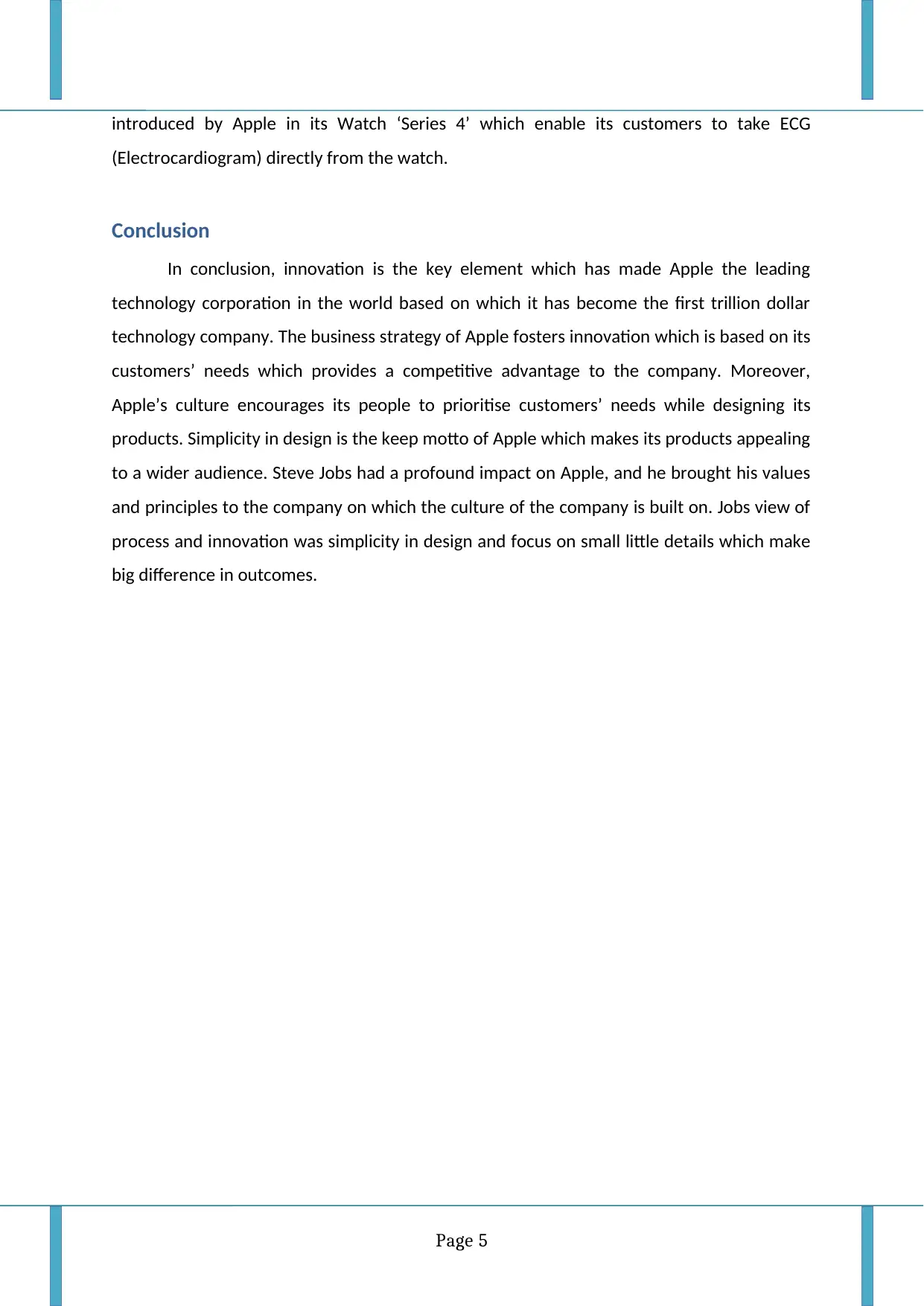
introduced by Apple in its Watch ‘Series 4’ which enable its customers to take ECG
(Electrocardiogram) directly from the watch.
Conclusion
In conclusion, innovation is the key element which has made Apple the leading
technology corporation in the world based on which it has become the first trillion dollar
technology company. The business strategy of Apple fosters innovation which is based on its
customers’ needs which provides a competitive advantage to the company. Moreover,
Apple’s culture encourages its people to prioritise customers’ needs while designing its
products. Simplicity in design is the keep motto of Apple which makes its products appealing
to a wider audience. Steve Jobs had a profound impact on Apple, and he brought his values
and principles to the company on which the culture of the company is built on. Jobs view of
process and innovation was simplicity in design and focus on small little details which make
big difference in outcomes.
Page 5
(Electrocardiogram) directly from the watch.
Conclusion
In conclusion, innovation is the key element which has made Apple the leading
technology corporation in the world based on which it has become the first trillion dollar
technology company. The business strategy of Apple fosters innovation which is based on its
customers’ needs which provides a competitive advantage to the company. Moreover,
Apple’s culture encourages its people to prioritise customers’ needs while designing its
products. Simplicity in design is the keep motto of Apple which makes its products appealing
to a wider audience. Steve Jobs had a profound impact on Apple, and he brought his values
and principles to the company on which the culture of the company is built on. Jobs view of
process and innovation was simplicity in design and focus on small little details which make
big difference in outcomes.
Page 5
⊘ This is a preview!⊘
Do you want full access?
Subscribe today to unlock all pages.

Trusted by 1+ million students worldwide
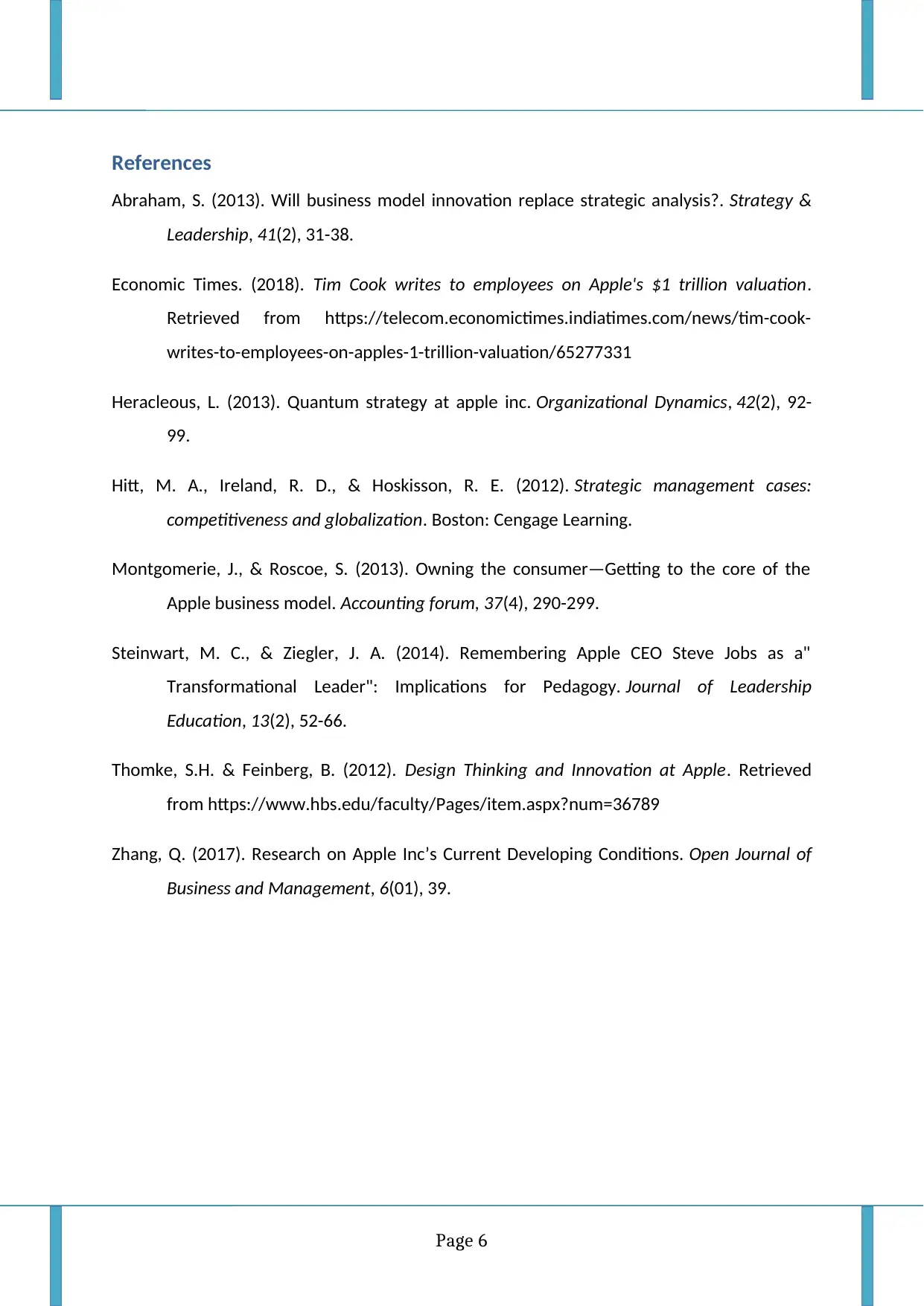
References
Abraham, S. (2013). Will business model innovation replace strategic analysis?. Strategy &
Leadership, 41(2), 31-38.
Economic Times. (2018). Tim Cook writes to employees on Apple's $1 trillion valuation.
Retrieved from https://telecom.economictimes.indiatimes.com/news/tim-cook-
writes-to-employees-on-apples-1-trillion-valuation/65277331
Heracleous, L. (2013). Quantum strategy at apple inc. Organizational Dynamics, 42(2), 92-
99.
Hitt, M. A., Ireland, R. D., & Hoskisson, R. E. (2012). Strategic management cases:
competitiveness and globalization. Boston: Cengage Learning.
Montgomerie, J., & Roscoe, S. (2013). Owning the consumer—Getting to the core of the
Apple business model. Accounting forum, 37(4), 290-299.
Steinwart, M. C., & Ziegler, J. A. (2014). Remembering Apple CEO Steve Jobs as a"
Transformational Leader": Implications for Pedagogy. Journal of Leadership
Education, 13(2), 52-66.
Thomke, S.H. & Feinberg, B. (2012). Design Thinking and Innovation at Apple. Retrieved
from https://www.hbs.edu/faculty/Pages/item.aspx?num=36789
Zhang, Q. (2017). Research on Apple Inc’s Current Developing Conditions. Open Journal of
Business and Management, 6(01), 39.
Page 6
Abraham, S. (2013). Will business model innovation replace strategic analysis?. Strategy &
Leadership, 41(2), 31-38.
Economic Times. (2018). Tim Cook writes to employees on Apple's $1 trillion valuation.
Retrieved from https://telecom.economictimes.indiatimes.com/news/tim-cook-
writes-to-employees-on-apples-1-trillion-valuation/65277331
Heracleous, L. (2013). Quantum strategy at apple inc. Organizational Dynamics, 42(2), 92-
99.
Hitt, M. A., Ireland, R. D., & Hoskisson, R. E. (2012). Strategic management cases:
competitiveness and globalization. Boston: Cengage Learning.
Montgomerie, J., & Roscoe, S. (2013). Owning the consumer—Getting to the core of the
Apple business model. Accounting forum, 37(4), 290-299.
Steinwart, M. C., & Ziegler, J. A. (2014). Remembering Apple CEO Steve Jobs as a"
Transformational Leader": Implications for Pedagogy. Journal of Leadership
Education, 13(2), 52-66.
Thomke, S.H. & Feinberg, B. (2012). Design Thinking and Innovation at Apple. Retrieved
from https://www.hbs.edu/faculty/Pages/item.aspx?num=36789
Zhang, Q. (2017). Research on Apple Inc’s Current Developing Conditions. Open Journal of
Business and Management, 6(01), 39.
Page 6
1 out of 7
Related Documents
Your All-in-One AI-Powered Toolkit for Academic Success.
+13062052269
info@desklib.com
Available 24*7 on WhatsApp / Email
![[object Object]](/_next/static/media/star-bottom.7253800d.svg)
Unlock your academic potential
Copyright © 2020–2025 A2Z Services. All Rights Reserved. Developed and managed by ZUCOL.





